“Collectors” Episode Premieres Nationwide December 27, 2024
WHAT: Renowned entertainer and Chicano art collector Cheech Marin, along with celebrated artists Yolanda González, Francisco Palomares, Frank Romero, and Jaime “Germs” Zacarias, is featured in the PBS Peabody Award-winning series Craft in America. Airing this month and now streaming nationwide, the “Collectors” episode explores the vital role that collectors play in the craft community and celebrates how their support inspires artists and enriches their lives. It includes insights from collectors nationwide and highlights Marin’s dedication to promoting Chicano art.
WHEN + WHERE
-
Broadcast Premiere: PBS on Friday, December 27, 2024 at 10 PM (ET) – check local listings
-
Streaming: Watch now on the PBS App, pbs.org/craftinamerica, and craftinamerica.org
WATCH
-
Video Clip: Preview of Cheech on Collecting Chicano Art
-
Full Episode: Cheech Marin’s segment begins at 38:44
WHY: The episode offers an intimate look at Marin’s efforts to elevate Chicano art, focusing on The Cheech Marin Center for Chicano Art & Culture of the Riverside Art Museum (“The Cheech”). Featured interviews include Marin, artists from his collection (González, Palomares, Romero, and Zacarias), María Esther Fernández (Artistic Director, The Cheech), Drew Oberjuerge (Executive Director, Riverside Art Museum), collector Todd Wingate, and Marin’s longtime art advisor, Melissa Richardson Banks.
EDUCATION GUIDE FOR GRADES 9–12: A free, downloadable lesson plan titled Building a Collection is available for educators. This resource helps students explore Chicano art and the significance of collecting, inspired by Marin’s collection and The Cheech. Access the guide at craftinamerica.org.
EPISODE-RELATED EXHIBITION: To see works by the artists featured in the episode, visit The Cheech and explore Shifting Perspectives: Cheech Collects, on view through April 27, 2025. The next edition of the annual “Cheech Collects” exhibition debuts on May 24, 2025.
ABOUT CRAFT IN AMERICA: Craft in America is a Peabody Award-winning PBS documentary series dedicated to exploring the significance of handmade objects and the artists who create them. Produced by the Los Angeles-based nonprofit organization Craft in America, Inc., the series promotes the beauty and relevance of craft in American culture. For more information, visit craftinamerica.org.
ABOUT RIVERSIDE ART MUSEUM: RAM operates two cultural landmarks in Riverside, California: the historic Julia Morgan Building, housing exhibitions since 1967, and The Cheech Marin Center for Chicano Art & Culture, opened in 2022. Together, they celebrate diverse art forms, offer educational programs, and inspire lifelong appreciation for the arts. To learn more, visit riversideartmuseum.org.
By Valerie Milano and Sarah Key
Los Angeles, CA. (The Hollywood Times) 09/22/2024- In life, one may receive signs that they are meant to do something more, special, or even extravagant. Signs may allude to change is coming from the universe in many forms. They may be through synchronicities, intuitive knowing, or even coincidences. Actor, comedian, and art collector Cheech Marin found his calling through a quite fitting and hilarious sign from the universe to begin his journey with The Cheech Museum in Riverside, California.
Click below to see our exclusive interview with Cheech Marin:
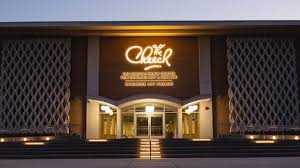
You may know Cheech Marin as an actor in the Cheech and Chong film series, but what you might not know about Marin, behind the scenes, is that he is an avid art collector and historian of Chicano Art. PBS SoCal’s ARTBOUND series is celebrating Chicano Art and History with their new season premiering October 4th on all PBS platforms. There is an episode solely focused on The Cheech and what it brings to the table for Chicano history and education. Cheech is quite proud of what his museum has become, as he never expected to be presented with this opportunity.
“That ARTBOUND episode, it turned out so great. It turned out really beautiful, and I’m really proud of it. I just let it speak for itself. It’s a really good inside look of what’s happening,” Marin said.
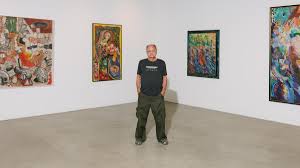
Located in the heart of Riverside, California, a city in rich history, Marin found it be a perfect location for the museum. He feels that the artwork contained there portrays diverse cultures from around the world.
“It’s a beautiful building and in a beautifully cultural, California town. Historic town! In the 1880’s, Riverside was the richest per capita city in the United States because of citrus. They grew everything citrus, and they exported it throughout the world, you know, so they had a lot of money and a small population. They built all these historic buildings on Mission Boulevard, the last one being the library which became The Cheech. It’s a beautiful town to visit. It’s a beautiful town to stay in,” Marin added.
Since Marin was young, he found and developed his appreciation for art and started collecting it. Unbeknownst to what was ahead in his future, he started noticing how art took form in the real world through buildings and within the objects he was collecting. He also began to see the precedence art history was taking in shaping cultural appreciation.
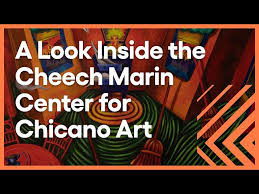 “I started appreciating art from a very young age because I had this group of cousins, and we were really, kind of, scholastic kids. I got assigned to learn about art and bring it back to the group, everything we know. So, I went to the library, started learning about art and so I, on an academic side, knew a lot about Western Art, but the people that were teaching me at the library encouraged me to go to museums because you have to see paintings live. That’s the only way to see them. I started doing that at a young age…so then when I got to the position that I had actual money to buy art, I started collecting Chicano Art because that’s what was happening…I saw what they were doing. I saw what it was, built on the precedent…after 50 years later we have our own museum, so it’s really cool,” Marin said.
“I started appreciating art from a very young age because I had this group of cousins, and we were really, kind of, scholastic kids. I got assigned to learn about art and bring it back to the group, everything we know. So, I went to the library, started learning about art and so I, on an academic side, knew a lot about Western Art, but the people that were teaching me at the library encouraged me to go to museums because you have to see paintings live. That’s the only way to see them. I started doing that at a young age…so then when I got to the position that I had actual money to buy art, I started collecting Chicano Art because that’s what was happening…I saw what they were doing. I saw what it was, built on the precedent…after 50 years later we have our own museum, so it’s really cool,” Marin said.
It is highly important to listen to those around you because they could end up being your biggest advocates towards a passion. Art has been around for thousands of years, and it is well known to be represented in religious settings. Cheech, being raised Catholic, was mesmerized by the ceilings at his church. The influences he had, on top of his experiences, truly brought about his passion for the art scene.

(Photo: Brian Feinzimer/for LAist )
“I was always a collector of something…stamps, coins, baseball cards, matchbook covers. Anything that, ‘Okay, get the whole set.’ I had a passion for codifying all the things I was collecting…When it came to art I thought, ‘I can’t afford any of this art to buy!’ I had no money, and I said, ‘But I can learn about it,’ and it was aided by being raised Catholic…from the 12th or 14th or century on that was the only art, you know, that was art. It was liturgical art, and every time I went into the church in my neighborhood, I’d be playing in a ceremony or whatever it was…and I started looking at the ceilings and there would be paintings on the ceilings of guys in sheets walking around the clouds and I went, ‘Why are they barbecuing that guy in the corner? What’s going on here?’ It was mayhem and mystery all at the same time. My favorite subjects, and so, I was attracted as a kid.”
Unfortunately, there are those who try to squash your dreams and aspirations in life as well. Once receiving a sign, it may be easy for its fuse to burn away ever so slowly based on the negative influences in your life. Marin was discouraged from becoming an artist himself as a child, due to a teacher who criticized his artwork.
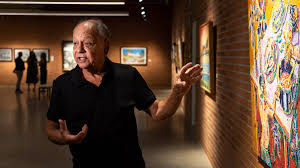
(Photo: Brian Feinzimer/for LAist )
“I was in first grade, and we took a trip. I was born in South Central L.A., down the street was the Grand Central Market, so the class was taking a field trip down there and everything that grew on the face of the earth was in that market. All these exotic plants, fruits, and vegetables, and I was just stunned. So, when we came back to class, the teacher said, ‘I want everybody to draw a picture of the thing that influenced them, or they were impressed the most.’ I saw these banana squashes…They were way taller than me, and I was always the littlest kid. I drew them with my big yellow crayons, and so, she went around the class admiring and commenting on everybody’s work, ‘Oh, well you used all the colors! That’s good! This is good!’ and she came to mine. She picked it up and looked at it and she goes, ‘Well, you’ll never be an artist.’ It was crushing to my soul like a knife in my heart…I just kind of crawled off in the corner somewhere a soul could die in peace, but I never gave up my love for art and learning about it…I didn’t know art was something you could learn how to do. I thought it was being fast, or being tall, or being skinny, or whatever that was you, and you came with those. I always admired art and kept going to museums and kept learning about art. I think it turned out alright in the end, you know? Every art group needs an advocate,” Marin said.
But that experience didn’t stop Marin from inspiring the world through his collection of Chicano Art and following his love for it. Through his collecting process, he also discovered who he is and that he is a Chicano himself. Marin found that the system tended to be unfair towards Chicanos, especially to ones like his father who didn’t speak fluent English. In a world where cultural diversity should have been appreciated and embraced, Marin found that not necessarily be true. Over time, Marin found himself identifying how the term “Chicano” was changing for the better in society.

“I think [Chicanos] are more embraced by society because they hear the message, and it’s a wide message. It’s been going on for a long time. My dad who died in ‘93, some years ago, always called himself a Chicano because that described him. That’s why I describe myself as a Chicano because that describes me. I hated the hyphenated terms. Mexican American. Italian American, Chinese American. You’re American or not man, c’mon. When that term came along, “Chicano,” that describes who I am. I’m not born in Mexico. I’m born in the United States, or I’ve lived here since my whole life and I have my cultural roots, but I also have an equal amount of Cheerios and watching Howdy Doody and The Ed Sullivan Show as anything else and as many new influences come into my world as there are old influences. Generally, Chicanos don’t speak the greatest Spanish in the world. And it depends on how either their parents speak or don’t speak or how many times they go to Mexico. But generally, you get in that school system and you’re gonna speak English. My father was punished for not speaking English when he went to his first day in school. Put in the corner because he couldn’t speak, so in that regard it’s changed a great deal.”
Artist Judy Baca, who is a great friend to Marin and included is the upcoming PBS episode, saw the powerful statement, “I’d rather live one day as a lion than a hundred years as a lamb,” graffitied on a wall. To Marin, this statement, along with many paintings created by the artists featured at The Cheech, describes the Chicano attitude and history.
 Marin calls all the artists featured at The Cheech his “kids” and finds them all telling the stories of Chicano history in their own creative ways. He also feels that they are bringing light to the issues that were previously ignored in Chicano history. Artist Vincent Valdez is one artist he finds that represents Chicano culture incredibly well in his artwork.
Marin calls all the artists featured at The Cheech his “kids” and finds them all telling the stories of Chicano history in their own creative ways. He also feels that they are bringing light to the issues that were previously ignored in Chicano history. Artist Vincent Valdez is one artist he finds that represents Chicano culture incredibly well in his artwork.
“There’s a painting by Vincent Valdez, who’s the artist of the day right now and everywhere. He’s just been voted Texas Artist of the Year and he’s gaining worldwide renown. I bought his first painting that he ever made when he came out of RISD, and it is called Kill The Pachuco Bastard! It is the story of the inception of the… murders… the sailors rampaged through the town of L.A. and attacked all the “Zoot Suiters” who were teenagers. They were 13, 14, maybe 15, and they were wearing these flamboyant suits in the age of austerity because we were in a war. They were in a war too. You went from zoot suiters to the front lines. That was a landmark time in the history of the United States, not just Chicano culture. He made a beautiful painting of it. It is currently our on the tour sponsored by LACMA…The Vincent Tour…It is absolutely gaining relevance, just like they learned and were influenced by the painters of any school that came before them. That option now, to be influenced by the Chicano school, is very much there, and it’s part of the continuum of American Art. I have this T-Shirt that says, ‘Chicano Art is American Art,'” Marin said.
 When asked about having a favorite artist, at The Cheech, he said, “That is like picking out your favorite kid.” It is difficult to pick just one artist who inspires him the most. “With all the new artists coming in, they show how powerful the influence of the artwork is, and they will continue to influence the artists that come after them.” Marin adds that he has known some of the artists for almost 50 years and seeing them develop is one of the most gratifying experiences for him. Marin had no idea he would take on the role as influencer and inspire them to share their artwork at The Cheech, however, he believes in signs and how things happen for a reason.
When asked about having a favorite artist, at The Cheech, he said, “That is like picking out your favorite kid.” It is difficult to pick just one artist who inspires him the most. “With all the new artists coming in, they show how powerful the influence of the artwork is, and they will continue to influence the artists that come after them.” Marin adds that he has known some of the artists for almost 50 years and seeing them develop is one of the most gratifying experiences for him. Marin had no idea he would take on the role as influencer and inspire them to share their artwork at The Cheech, however, he believes in signs and how things happen for a reason.
“I believe in that, because when you pray for something, if you pray for it…a request, and if you believe in that, it does a lot of directing energy towards that source. I was at a crossroads, and they asked me to give them the collection that I had put together for 50 years, and they would provide the building for as long as the building existed to show the collection, and every big collector comes to that same point at some point in their collecting, ‘What am I gonna do with this? I can’t keep it under the bed or in the closet, or garage. Every wall…every inch of every wall is covered in art. What do I do with the rest of it?’ They’re always faced with that quandary. I was fortunate enough to have a city come to me and offer me this request. I didn’t understand what they were saying at first. ‘You want me to buy a museum? I’m doing okay, but I don’t know if I’m museum rich at this point, you know?’ and they said, ‘No. No. We want to give you the building for the collection,’ and for any collector that is the dream come true.”

Marin received a most fitting sign for him to pursue the Chicano art museum offer which came in relation to his prior movie Cheech and Chong and the counterculture movement with drugs.
“When this offer came in, I didn’t understand what they were saying. ‘No. No. No. We want to give you the beep bap, but you have to give us [your collection] and we’ll take care of it, and it’ll be funded by the city and everything’. I really didn’t know whether I was gonna do this or not… I was looking for a sign. ‘Help me now! You got me into this so come on!’ I was walking across the floor one day and I was asking the person who knew, ‘how big is this building, cause it’s a fairly big building?’ He said, ‘66,420 square feet.’ I go, that’s it! Four hundred and twenty! 4/20! That’s the sign that I’m supposed to do this! And I believe in signs! So, there we were,” Marin said.
After acquiring the museum, pieces of artwork were beginning to be seen and artists recognized for their contributions to Chicano culture and history. After seeing his name emblazoned in lights, Marin realized that he was living the dream.

(Photo: Jasmine Marin)
“I think I didn’t allow myself to dream that because…it’s an impossible dream. I’m not going to waste any energy. I could do all this other stuff rather than having my name emblazoned on the side of a museum, but one night, after it was all said and done, and we had the museum, it was installed…the directors of the Riverside Art Museum, we were walking back from an event at the auditorium next door. He says, ‘hey, let’s walk by the front. We’ll show you something’ and we walk by. Then when I got to the front, they lit up the building and the sign lit up…At that point you don’t know what to say. The little nine-year-old kid in the library comes leaping out ‘Wow!’ It’s the most wow moment in your life.”
The inspiring influence of art spreading through visitors and the artists at The Cheech, Marin finds that they are imprinted in this continued legacy of Chicano studies. He shared that everybody has an influence, and that you don’t make art in a vacuum. His appearance along with the other talented artists on ARTBOUND, he feels, will make a strong impact bringing about change.

(Photo: Brian Feinzimer/for LAist )
“They’re now included in that continuum of history and so, you can see their influence spreading right from the OGs in the late 60’s to the present day, you know, because Chicano is an evolutionary term. What it does is combine everything that’s put in its path… all their history, all their cultural backgrounds from Mexico or any other Latin country that they come from and incorporates and spills out something new that nobody’s ever seen, and that’s what they’re doing. They are a part of art history, and so in that sense they’ve accomplished that message, but now we’re in our fourth generation of Chicano painters and you know, the establishment is spreading all across the country, especially in the Midwest where it always has been…Chicago is the second biggest repository of Chicanos and Mexicans in the United States outside of Los Angeles, who would’ve guessed that? I found that out the first time I went there. It was a Mexican restaurant across the street from the nightclub we were playing at, and I think, ‘Mexican food in Chicago? What are they gonna have like Sopa de Sauerkraut or something like that?’ but you go in there and you look and it’s the real thing, real kind of food and there’s nothing but Mexicans in there. I learned very quickly that there was a huge population of Mexicans there, right from maybe the late 30’s because of the advent of the railroads that could bring straight from Mexico into the heartland of the Midwest to work in the factories, the fields, the whatever jobs were available,” Marin added.
What is especially important are the younger generations of artists interested in pursuing art. Marin recommends they not only visit museums and research art, but also attend an art school to expand on their craft.

“Going to art school is as if you want to be the world’s best engineer, you go to a school that has good engineering, and if you want to be an artist, you go exactly to a good art school. It’s hard making your living as an actor, I know. I’ve been fortunate, but to make a living as an artist is 10x as hard because people don’t need art, or they think, in their life, as they’re surrounded already by art. It is a need of society, art. Any human being, whether carving on the side of a rock or doing graffiti…it is a need to express yourself. And graffiti and tagging and marking on walls has its own strict rules because it’s defining boundaries in neighborhoods and they’re very touchy about that,” Marin said.
As Marin calls the artists his “kids” he finds that there is a familial sense of connection with them, growing up in a similar background. Marin believes The Cheech is proof that they matter.

“Here is proof positive, we have our own museum, and you’re not really taken seriously as an art movement until you have your own museum. It was pointed out by [art critic] Christopher Knight in the review he wrote about the opening of The Cheech, and he listed this whole long list of art movements and groups that did not have a museum, such as the women’s movement, gay art… he went all down the line, and they don’t. The repetition went ‘and they don’t have a museum,’ and who would have thought that Chicano would be the one out of this group… I would imagine it because I’ve done the work for 50 years, and we’ve participated in 50 museums around the country and are known across the world. I saw it coming, and it was like a boulder that was rolling downhill. You either get out of the way or you hop on the back and ride it down, you know, but it’s not going to stop, as it shouldn’t stop, because it’s an addition to our art language in this world. It’s a worthy language,” Marin added.
The Cheech is proof that dreams are possible for these artists, and there is always a place for them to be displayed amongst other talented artists. Marin recognizes art as something that attracts him, something that has great elements to it. Artistic value plays a great part in his collecting process, and when asked if he sees himself reflected within the artwork at The Cheech, he quipped, “Oh, yeah! I’m the Mona Lisa of Chicano Art!”
 Marin believes that Chicanos have an artistic talent already equipped into their brain, ready to present a story on canvas.
Marin believes that Chicanos have an artistic talent already equipped into their brain, ready to present a story on canvas.
“Chicanos were not included or encouraged to be part of the abstract construction or installation art because they come from a very long painting tradition. They never gave up the brush and it’s the most, kind of, immediate impulse. You get the inspiration for an art, and it comes out of your brain and through your arm and into a stick with hair on it. It’s the most primitive way of making art, and they have made it better. They have added their own influence in it…but they are involved in all kinds of forms of doing art right now. ‘Okay we’ll let you into this show, be a part of this show.’ That’s increasingly happening. The young Chicanos and Chicanas, my daughter included, go to these prestigious art schools. She went to the School of The Art Institute in Chicago where she met a lot of other Chicanos who she didn’t even know from L.A… They are doing well and having a kind of almost natural in-born street instinct of what’s happening around them. The combination of those elements really creates something different, something unique but something that we share in common in some aspect, so it’s a good movement…Its big,” Marin said.
Marin’s legacy is incredibly strong whether it’s because of his acting career or his involvement within the community, however, Marin hopes to be remembered more for The Cheech and the collection within.
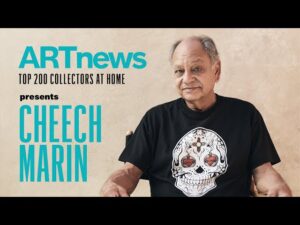 “I will be remembered more for The Cheech than anything else because it’s a cultural institution and as long as it’s supported it will be there. It may come in and out of knowing who I am, vis-a-vis entertainment and being Cheech or being an actor. I’m at the stage of life where young kids go, ‘Oh yeah that guy! I know that guy. He’s in every movie,’ but The Cheech, it’s there and it’s open every day just about. Hopefully it will be open forever. I was told, when we first started this project, by museum executives, ‘You’re not considered a museum until you’ve been there at least 20 years.’ Okay, hoping for twenty here! We got 17 more to go, so c’mon Chicanos! I think this museum will carry on. The longer it stays there, the longer it will stay there because it’s a progressive movement. It’s an evolutionary movement. We keep creating these artists and interpreting their cultural experiences, their neighborhoods. This is what my neighborhood looks like. These are what the people in my neighborhood look like. These are their joys and their sadnesses and their problems, but it’ll keep changing as my neighborhood changes,” Cheech concluded.
“I will be remembered more for The Cheech than anything else because it’s a cultural institution and as long as it’s supported it will be there. It may come in and out of knowing who I am, vis-a-vis entertainment and being Cheech or being an actor. I’m at the stage of life where young kids go, ‘Oh yeah that guy! I know that guy. He’s in every movie,’ but The Cheech, it’s there and it’s open every day just about. Hopefully it will be open forever. I was told, when we first started this project, by museum executives, ‘You’re not considered a museum until you’ve been there at least 20 years.’ Okay, hoping for twenty here! We got 17 more to go, so c’mon Chicanos! I think this museum will carry on. The longer it stays there, the longer it will stay there because it’s a progressive movement. It’s an evolutionary movement. We keep creating these artists and interpreting their cultural experiences, their neighborhoods. This is what my neighborhood looks like. These are what the people in my neighborhood look like. These are their joys and their sadnesses and their problems, but it’ll keep changing as my neighborhood changes,” Cheech concluded.
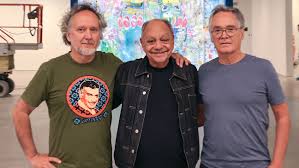
PBS SoCal’s ARTBOUND episode The Cheech with Cheech Marin will premiere October 4th on all PBS streaming platforms.
“The Cheech:” https://youtu.be/
Actor Cheech Marin helps open permanent showcase of Chicano art and culture (youtube.com)





